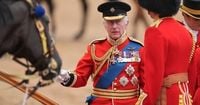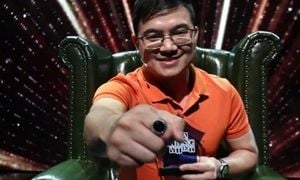On a bright and warm Saturday, June 14, 2025, London once again came alive with the stirring spectacle of Trooping the Colour, the traditional celebration marking King Charles III's official birthday. Thousands lined the streets of The Mall, eager to witness the grand parade that featured more than 1,400 soldiers, 400 musicians, and 200 horses making their stately procession to Horse Guards Parade.
The day’s festivities culminated in a breathtaking flypast by the Royal Air Force’s famed Red Arrows over Buckingham Palace, an event made even more remarkable this year by an eco-conscious innovation. For the first time at a public event, the Red Arrows used a more environmentally friendly blend of fuel, incorporating sustainable aviation fuel and a biofuel for their iconic red, white, and blue vapor trails. This move aligns with King Charles’s well-known commitment to environmental causes, as he has long championed the use of sustainable aviation fuel on royal flights and is keen to promote its broader adoption.
The royal family was present in full regalia, with King Charles and Queen Camilla receiving cheers from the crowds as they exited Buckingham Palace. The Queen wore a stunning white silk crepe dress embroidered with silver by designer Anna Valentine, complemented by a hat from Philip Treacy and a Grenadier Guards brooch, symbolizing her honorary military role.
His Majesty, as Colonel-in-Chief of the Household Division, donned the Coldstream Guards’ tunic and forage cap, honoring the regiment whose Colour was being trooped this year. Notably, his uniform still bore the cypher of his late mother, Queen Elizabeth II, a poignant tribute reflecting his previous role as her Personal Aide-de-Camp.
Princess Catherine, the Princess of Wales, returned to the dais this year in her role as Colonel of the Irish Guards, a position she resumed after missing the 2024 parade due to medical treatment. She looked elegant in a dress coat by Catherine Walker, a hat by Juliette Botterill, the Irish Guards Regimental Brooch, and the late Queen’s Bahrain Pearl earrings. Her children—Prince George, Princess Charlotte, and Prince Louis—were cared for by their nanny, Maria, inside a Ministry of Defence building overlooking the parade grounds.
The Duke and Duchess of Gloucester rode in the No. 2 Barouche carriage, a type of elegant horse-drawn vehicle with a history dating back to the early 19th century, painted in the traditional royal claret color. Meanwhile, the Duchess of Edinburgh accompanied Vice Admiral Sir Timothy Laurence in the No. 1 Barouche, while other members of the royal family took to horseback. Prince William, Colonel of the Welsh Guards, rode Darby, a horse gifted in 2019 to commemorate the Royal Canadian Mounted Police’s breeding program anniversary and the 50th anniversary of Burmese, the famous regimental horse.
Princess Anne, the Princess Royal and Colonel of The Blues and Royals, wore the full mounted ceremonial uniform and carried the Gold Stick as Gold Stick-in-Waiting, a role of great ceremonial importance. Prince Edward, Duke of Edinburgh and Colonel of the Scots Guards, appeared in the full ceremonial guard order of his regiment, adorned with numerous medals and insignia reflecting his distinguished service and royal duties.
Interestingly, royal enthusiasts have revisited a minor uniform detail from last year’s parade, where King Charles was spotted wearing the waist sash of a general officer of the Irish Guards rather than the traditional colonel’s sash for the regiment. While some viewed it as a faux pas, the Royal Family clarified that the monarch wears the uniform of the regiment whose Colour is being trooped, a tradition that underscores the sovereign’s ceremonial role. Some speculate the discrepancy might have been due to practical reasons, such as the correct sash being unavailable or undergoing repair.
Trooping the Colour itself is steeped in history, dating back over 260 years to the reign of King Charles II in the 17th century. Originally, the parade served a practical military purpose: regimental flags, called "Colours," acted as rallying points on the battlefield. Young officers would march between ranks holding the Colours high, ensuring troops could recognize their units. By 1748, the parade was adopted to mark the official birthday of the British Sovereign, becoming an annual event after George III ascended the throne in 1760. Like King Charles III, George III was born in November, but the parade was moved to June to take advantage of more favorable weather conditions in the UK.
The parade this year also marked King Charles’s third official Trooping the Colour as monarch. His first attendance was in 1951 as a young child, riding in a carriage with Queen Elizabeth The Queen Mother and Princess Margaret. He first rode in the parade himself in 1975 as Colonel of the Welsh Guards, a role he has maintained with great dedication.
Behind the scenes, the Royal Family shared glimpses of the final preparations, including a video showing staff readying horses and carriages, some wearing black armbands—a subtle nod to recent royal mourning. The day’s arrangements balanced tradition and modernity, with carriages like the Ascot Landau carrying the Princess of Wales and her children, and horses like Noble and Sir John ridden by Princess Anne and Prince Edward, respectively.
Notably absent from this year’s parade were Lady Louise and the Earl of Wessex, likely due to their ongoing studies, underscoring the royal family’s commitment to education amid public duties.
As the Red Arrows soared overhead, trailing their eco-friendly vapors, the crowd was reminded that even centuries-old traditions can evolve to meet the challenges of today. This Trooping the Colour was not only a celebration of royal pageantry and history but also a reflection of a monarchy striving to align with contemporary values, particularly environmental stewardship, championed by King Charles himself.




